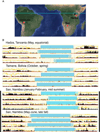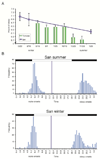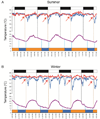Natural sleep and its seasonal variations in three pre-industrial societies
- PMID: 26480842
- PMCID: PMC4720388
- DOI: 10.1016/j.cub.2015.09.046
Natural sleep and its seasonal variations in three pre-industrial societies
Abstract
How did humans sleep before the modern era? Because the tools to measure sleep under natural conditions were developed long after the invention of the electric devices suspected of delaying and reducing sleep, we investigated sleep in three preindustrial societies [1-3]. We find that all three show similar sleep organization, suggesting that they express core human sleep patterns, most likely characteristic of pre-modern era Homo sapiens. Sleep periods, the times from onset to offset, averaged 6.9-8.5 hr, with sleep durations of 5.7-7.1 hr, amounts near the low end of those industrial societies [4-7]. There was a difference of nearly 1 hr between summer and winter sleep. Daily variation in sleep duration was strongly linked to time of onset, rather than offset. None of these groups began sleep near sunset, onset occurring, on average, 3.3 hr after sunset. Awakening was usually before sunrise. The sleep period consistently occurred during the nighttime period of falling environmental temperature, was not interrupted by extended periods of waking, and terminated, with vasoconstriction, near the nadir of daily ambient temperature. The daily cycle of temperature change, largely eliminated from modern sleep environments, may be a potent natural regulator of sleep. Light exposure was maximal in the morning and greatly decreased at noon, indicating that all three groups seek shade at midday and that light activation of the suprachiasmatic nucleus is maximal in the morning. Napping occurred on <7% of days in winter and <22% of days in summer. Mimicking aspects of the natural environment might be effective in treating certain modern sleep disorders.
Copyright © 2015 Elsevier Ltd. All rights reserved.
Conflict of interest statement
The authors have no conflicts to disclose.
Figures




Comment in
-
Biological rhythms: Human sleep before the industrial era.Nature. 2015 Nov 12;527(7577):176-7. doi: 10.1038/527176a. Nature. 2015. PMID: 26560297 No abstract available.
-
Human Behavior: Sleep in Hunter-Gatherer Societies.Curr Biol. 2015 Dec 7;25(23):R1133-5. doi: 10.1016/j.cub.2015.10.012. Curr Biol. 2015. PMID: 26654373
-
Segmented Sleep in Preindustrial Societies.Sleep. 2016 Mar 1;39(3):715-6. doi: 10.5665/sleep.5558. Sleep. 2016. PMID: 26888454 Free PMC article. No abstract available.
-
Ancestral sleep.Curr Biol. 2016 Apr 4;26(7):R271-2. doi: 10.1016/j.cub.2016.01.071. Curr Biol. 2016. PMID: 27046809
-
Response to de la Iglesia et al.Curr Biol. 2016 Apr 4;26(7):R273-4. doi: 10.1016/j.cub.2016.02.057. Curr Biol. 2016. PMID: 27046810 Free PMC article.
References
-
- Marlowe F. The Hadza Hunter-Gatherers of Tanzania. Berkley and Los Angeles: University of California Press; 2010.
-
- Heeren M, Sojref F, Schuppner R, Worthmann H, Pflugrad H, Tryc AB, Pasedag T, Weissenborn K. Active at night, sleepy all day: Sleep disturbances in patients with hepatitis C virus infection. Journal of Hepatology. 2014;60:732–740. - PubMed

